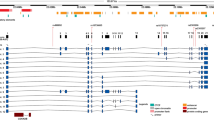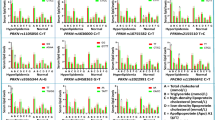Abstract
Inflammation is now considered critical in the pathogenesis of myocardial infarction. One of the mechanisms regulating the inflammatory process is the ubiquitin-proteasome system. We investigated whether variants of the 20S proteasome are associated with susceptibility to myocardial infarction and found a common SNP (minor allele frequency of 0.35) in the proteasome subunit α type 6 gene (PSMA6) conferring risk of myocardial infarction in the Japanese population (χ2 = 21.1, P = 0.0000044, 2,592 affected individuals versus 2,851 controls). We replicated this association in another panel of myocardial infarction and control subjects, although its relevance to other ethnic groups remains to be clarified. The SNP, located in the 5′ untranslated region of exon 1 in this gene, enhanced the transcription of PSMA6. Moreover, suppression of PSMA6 expression using short interfering RNA in cultured cells reduced activation of the transcription factor NF-κB by stabilizing phosphorylated IκB. Our results implicate this PSMA6 SNP as a previously unknown genetic risk factor for myocardial infarction.
This is a preview of subscription content, access via your institution
Access options
Subscribe to this journal
Receive 12 print issues and online access
$209.00 per year
only $17.42 per issue
Buy this article
- Purchase on Springer Link
- Instant access to full article PDF
Prices may be subject to local taxes which are calculated during checkout



Similar content being viewed by others
Accession codes
References
Hansson, G.K. Inflammation, atherosclerosis, and coronary artery disease. N. Engl. J. Med. 352, 1685–1695 (2005).
Yamada, Y. et al. Prediction of the risk of myocardial infarction from polymorphisms in candidate genes. N. Engl. J. Med. 347, 1916–1923 (2002).
Ozaki, K. et al. Functional SNPs in the lymphotoxin-α gene that are associated with susceptibility to myocardial infarction. Nat. Genet. 32, 650–654 (2002).
Wang, L., Fan, C., Topol, S.E., Topol, E.J. & Wang, Q. Mutation of MEF2A in an inherited disorder with features of coronary artery disease. Science 302, 1578–1581 (2003).
Helgadottir, A. et al. The gene encoding 5-lipoxygenase activating protein confers risk of myocardial infarction and stroke. Nat. Genet. 36, 233–239 (2004).
Ozaki, K. et al. Functional variation in LGALS2 confers risk of myocardial infarction and regulates lymphotoxin-α secretion in vitro. Nature 429, 72–75 (2004).
Cipollone, F. et al. A polymorphism in the cyclooxygenase 2 gene as an inherited protective factor against myocardial infarction and stroke. J. Am. Med. Assoc. 291, 2221–2228 (2004).
Pajukanta, P. et al. Two loci on chromosomes 2 and X for premature coronary heart disease identified in early- and late-settlement populations of Finland. Am. J. Hum. Genet. 67, 1481–1493 (2000).
Broeckel, U. et al. A comprehensive linkage analysis for myocardial infarction and its related risk factors. Nat. Genet. 30, 210–214 (2002).
Harrap, S.B. et al. Genome-wide linkage analysis of the acute coronary syndrome suggests a locus on chromosome 2. Arterioscler. Thromb. Vasc. Biol. 22, 874–878 (2002).
Wang, Q. et al. Premature myocardial infarction novel susceptibility locus on chromosome 1P34–36 identified by genomewide linkage analysis. Am. J. Hum. Genet. 74, 262–271 (2004).
Hauser, E.R. et al. A genomewide scan for early-onset coronary artery disease in 438 families: the GENECARD Study. Am. J. Hum. Genet. 75, 436–447 (2004).
Samani, N.J. et al. A genomewide linkage study of 1,933 families affected by premature coronary artery disease: the British Heart Foundation (BHF) Family Heart Study. Am. J. Hum. Genet. 77, 1011–1020 (2005).
Karin, M. & Delhase, M. The IκB kinase (IKK) and NF-κB: key elements of proinflammatory signalling. Semin. Immunol. 12, 85–98 (2000).
Maki, C.G., Huibregtse, J.M. & Howley, P.M. In vivo ubiquitination and proteasome-mediated degradation of p53(1). Cancer Res. 56, 2649–2654 (1996).
Salghetti, S.E., Kim, S.Y., & Tansey, W P. Destruction of Myc by ubiquitin-mediated proteolysis: cancer-associated and transforming mutations stabilize Myc. EMBO J. 18, 717–726 (1999).
Dimmeler, S., Breitschopf, K., Haendeler, J. & Zeiher, A.M. Dephosphorylation targets Bcl-2 for ubiquitin-dependent degradation: a link between the apoptosome and the proteasome pathway. J. Exp. Med. 189, 1815–1822 (1999).
Ross, R. Atherosclerosis—an inflammatory disease. N. Engl. J. Med. 340, 115–126 (1999).
Beinke, S. & Ley, S.C. Functions of NF-κB1 and NF-κB2 in immune cell biology. Biochem. J. 382, 393–409 (2004).
Coux, O., Tanaka, K. & Goldberg, A.L. Structure and functions of the 20S and 26S proteasomes. Annu. Rev. Biochem. 65, 801–847 (1996).
International HapMap Consortium. A haplotype map of the human genome. Nature 437, 1299–1320 (2005).
Haga, H., Yamada, R., Ohnishi, Y., Nakamura, Y. & Tanaka, T Gene-based SNP discover as part of the Japanese Millennium Genome project: identification of 190,562 genetic variations in the human genome. J. Hum. Genet. 47, 605–610 (2002).
Freedman, M.L. et al. Assessing the impact of population stratification on genetic association studies. Nat. Genet. 36, 388–393 (2004).
Lo, H.S. et al. Allelic variation in gene expression is common in the human genome. Genome Res. 13, 1855–1862 (2003).
Herrmann, J., Ciechanover, A., Lerman, L.O. & Lerman, A. The ubiquitin-proteasome system in cardiovascular diseases—a hypothesis extended. Cardiovasc. Res. 61, 11–21 (2004).
Meiners, S. et al. Ubiquitin-proteasome pathway as a new target for the prevention of restenosis. Circulation 105, 483–489 (2002).
Pye, J. et al. Proteasome inhibition ablates activation of NF-κB in myocardial reperfusion and reduces reperfusion injury. Am. J. Physiol. Heart Circ. Physiol. 284, H919–H926 (2003).
Elliott, P.J., Zollner, T.M. & Boehncke, W.H. Proteasome inhibition: a new anti-inflammatory strategy. J. Mol. Med. 81, 235–245 (2003).
Pritchard, J.K. & Rosenberg, N.A. Use of unlinked genetic markers to detect population stratification in association studies. Am. J. Hum. Genet. 65, 220–228 (1999).
den Dunnen, J.T. & Antonarakis, S.E. Mutation nomenclature extensions and suggestions to describe complex mutations: a discussion. Hum. Mutat. 15, 7–12 (2000).
Acknowledgements
We thank M. Takahashi, M. Yoshii, S. Abiko, W. Yamanobe, M. Omotezako, Y. Ariji, R. Ohishi, M. Watabe, K. Tabei and S. Manabe for their assistance and A. Suzuki and K. Kobayashi for advice on allele-specific gene expression experiments. We also thank all the other members of SNP Research Center, RIKEN and OACIS for their contribution to the completion of our study. We are also grateful to members of The Rotary Club of Osaka-Midosuji District 2660 Rotary International in Japan for supporting our study. This work was supported in part by grants from the Takeda Science Foundation, the Uehara Science Foundation and the Japanese Millennium Project.
Author information
Authors and Affiliations
Contributions
K.O. performed most of the experiments and wrote the manuscript; H.S., H.M., Y.M., S.I. and M.H. managed DNA samples and clinical information; A.I. contributed to SNP discovery; T.N., A.T., T. Tsunoda and N.K. performed the data analyses; Y.N. contributed to SNP discovery and preparation of the manuscript; T. Tanaka supervised this study.
Note: Supplementary information is available on the Nature Genetics website.
Corresponding author
Ethics declarations
Competing interests
The authors declare no competing financial interests.
Supplementary information
Supplementary Table 1
Association analyses between myocardial infarction and SNPs in genes encoding 20S proteasome α and β subunits. (PDF 140 kb)
Supplementary Table 2
Pairwise LD coefficients (upper; r2; lower; D1) among SNPs in PSMA6 region. (PDF 25 kb)
Supplementary Table 3
Association analyses of haplotypes in PSMA6 region with MI. (PDF 24 kb)
Supplementary Table 4
No association of HT, smoking and past history of MI with the PSMA6 SNP. (PDF 33 kb)
Supplementary Table 5
Clinical parameters of MI patients and the PSMA6 SNP genotype. (PDF 17 kb)
Supplementary Table 6
Replication of association with the second panel. (PDF 36 kb)
Supplementary Table 7
Primer sequences used in the study. (PDF 9 kb)
Rights and permissions
About this article
Cite this article
Ozaki, K., Sato, H., Iida, A. et al. A functional SNP in PSMA6 confers risk of myocardial infarction in the Japanese population. Nat Genet 38, 921–925 (2006). https://doi.org/10.1038/ng1846
Received:
Accepted:
Published:
Issue Date:
DOI: https://doi.org/10.1038/ng1846
This article is cited by
-
A novel 14q13.1–21.1 deletion identified by CNV-Seq in a patient with brain-lung-thyroid syndrome, tooth agenesis and immunodeficiency
Molecular Cytogenetics (2019)
-
Pathogenic copy number variants that affect gene expression contribute to genomic burden in cerebral palsy
npj Genomic Medicine (2018)
-
Distinct and Shared Determinants of Cardiomyocyte Contractility in Multi-Lineage Competent Ethnically Diverse Human iPSCs
Scientific Reports (2016)
-
Molecular genetics of coronary artery disease
Journal of Human Genetics (2016)
-
Genetic variations in the PSMA3, PSMA6 and PSMC6 genes are associated with type 1 diabetes in Latvians and with expression level of number of UPS-related and T1DM-susceptible genes in HapMap individuals
Molecular Genetics and Genomics (2016)



